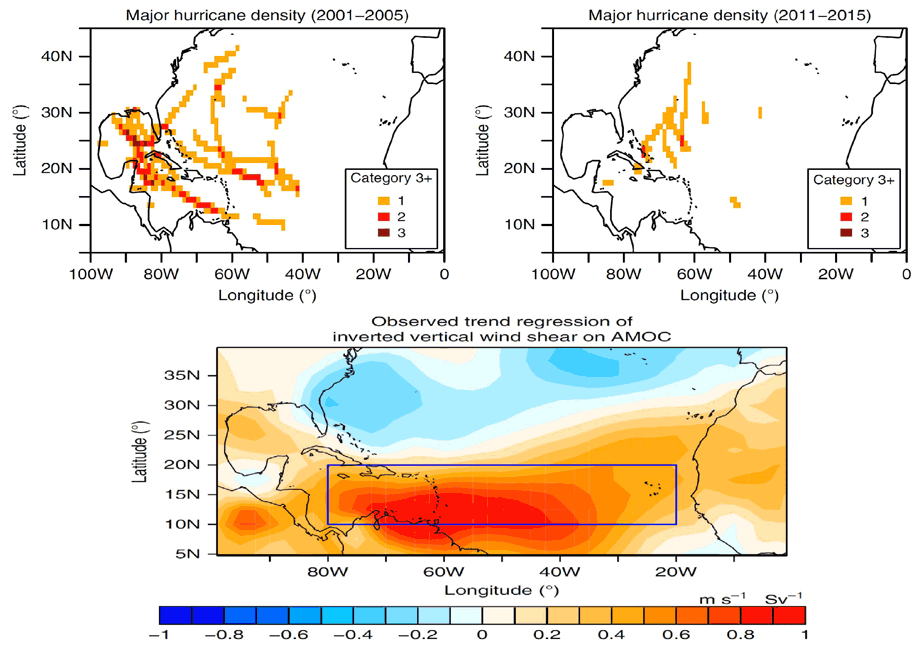The Role of Atlantic Overturning Circulation in the Recent Decline of Atlantic Major Hurricane Frequency – Geophysical Fluid Dynamics Laboratory (original) (raw)
January 31st, 2018
Key Findings
- A pronounced decline over the period 2005-2015 is identified in Atlantic major hurricane frequency, as well as in the Atlantic Multidecadal Variability (AMV), while an increase is identified in the vertical wind shear over the Atlantic hurricane main development region
- Ocean observations and simulations from GFDL Earth System Model (ESM2G) show that the recent decline in Atlantic major hurricane frequency since 2005 is consistent with a weakening of AMOC
- Coherent multidecadal variations involving the inferred AMOC and Atlantic major hurricane frequency, along with indices of AMV and inverted vertical wind shear, exist over the entire period since the middle of the 20th century. Our results provide compelling evidence for an important role of the AMOC in the recent decline of Atlantic major hurricane frequency since 2005
Xiaoqin Yan, Rong Zhang, Thomas R. Knutson. Nature Communications. DOI:10.1038/s41467-017-01377-8
Observed Atlantic major hurricane frequency has exhibited pronounced multidecadal variability since the 1940s. However, the cause of this variability is debated. This study explores the causes of the recent decline of Atlantic major hurricane frequency over the period 2005-2015, using various observational datasets and modeling results from a 500-year control simulation of a fully coupled earth system model, GFD’s ESM2G. The authors’ findings show that the recent decline in Atlantic major hurricane frequency since 2005 is consistent with a weakening of AMOC inferred from ocean observations.
ESM2G is unique among for a global climate model, in that its ocean component employs an isopycnal-coordinate, in contrast to most global climate models, which use z-coordinate ocean components. The AMOC structure (especially the depth of AMOC) and the deep overflow in the North Atlantic mean state are far more realistic in isopycnal-coordinate models with more realistic mixing than in z-coordinate models.
The improved AMOC structure and deep overflow in the North Atlantic can greatly reduce the systematic large cold sea surface temperature bias in the extra-tropical North Atlantic, which often leads to a biased mean state environment for tropical cyclones. These results suggest an important role of the recent AMOC weakening in the decline of Atlantic major hurricane frequency since 2005.
Changes of North Atlantic hurricane have significant large-scale social, economic and climatic impacts. Understanding the mechanisms of North Atlantic hurricane will help to predict future changes in North Atlantic hurricane and associated social, economic and climatic impacts. Therefore, monitoring and predicting AMOC changes will be important to reduce future Atlantic hurricane risk.

Observed historical Atlantic major hurricane activity and trend regression of inverted vertical wind shear on the AMOC. Upper panels: Atlantic major hurricane track density maps for the periods 2001–2005 and 2011–2015, respectively. The track density shows the total number of major hurricanes (Category 3+) that occurred at each grid box within each period. Lower panel: Regression of 11-year trends of inverted hurricane season vertical shear of zonal wind on the AMOC index at 26°N. The box shows the Atlantic hurricane main development region. Positive values imply an increase in vertical wind shear (favoring a decrease of Atlantic major hurricane frequency) when AMOC declines, and vice versa.